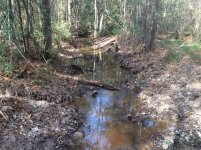When the creek is flowing the fastest- what is the depth and width? That is what you have to plan for in sizing your culvert to avoid wash outs. Corrugated culverts come in all sizes - even on craigs list. I have only opinion- but I would think that you would never want as much as a 1/3 of the culvert full during peak flow to avoid a washout.
Found this:
Instructions
Sizing
1
Find the high-water mark of the stream. This is the level at which vegetation meets bare earth and rock. Drive a stake into the high-water line on either bank. Connect the stakes with string and measure the distance.
2
Find the low-water level of the stream. This is typically the level at which the slopes of the stream banks flatten into the stream bottom. Measure the width at this level.
3
Find the depth of the stream at high water. Simply measure the height from the stream bottom to the string marking the high-water line. You can take several measurements and average them if the depth is very irregular.
4
To find the cross-sectional area of the stream, simply take the average of the high-water width and the low-water width and multiply it by the depth at high water. The cross-sectional area of the culvert should be at least 1.25 times that of the stream. If the stream is at high risk of flooding, though, the factor should be 1.75 for 25-year floods or 3 for 50- to 100-year floods. Use the chart in Resources if you need help converting the culvert's cross-sectional area to a diameter.
5
Measure the width of the roadway and its adjacent side slopes to determine the length of your culvert. The length of your culvert should equal this width plus two feet.
Installation
1
Excavate at least 6 inches from the bed of the stream. Follow the slope of the stream when you excavate, which typically measures between 2 and 6 percent. If your excavated slope is less than 2 percent, water can stagnate in the culvert.
2
Fill the 6-inch trough you've created with soil or sand. Pack it in with the soil compactor.
3
Place and center your culvert. All but the smallest of culverts will require a backhoe for this operation.
4
Fill around the culvert with soil or sand. Pack the material in after every 6 inches of fill, and be sure that it is free of rocks. Cover the culvert with at least a foot of fill material.
5
Seed the top of the culvert with grass, or lay sod over it. You may choose to spread and pack gravel over the roadway section. Protect the dirt around the culvert by jamming flat rocks or broken concrete into the stream bed around each mouth of the culvert.
Read more :
How to Lay Culverts | eHow


